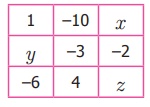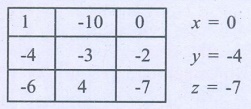Questions with Answers, Solution | Number System | Term 1 Chapter 1 | 7th Maths - Exercise 1.6 | 7th Maths : Term 1 Unit 1 : Number System
Chapter: 7th Maths : Term 1 Unit 1 : Number System
Exercise 1.6
Exercise 1.6
Miscellaneous Practice problems
1. What Should be
added to −1 to get 10?
Answer: 11
2. −70 + 20 = –40 −10
3. Subtract 94860
from ( −86945)
–86945 – 94860 = – 1,81,805
4. Find the value of
(–25)+60+(–95)+(–385)
(–25) + 60 (–95) + (–385)
+ 60 + (–25 – 95 – 385)
+ 60 –505 = – 445
5. Find the sum of
(–9999) ( −2001)and ( −5999)
–9999 +
–2001
–5999
---------
–17999
----------
6. Find the product
of (−30) × ( −70) ×15
2100 × 15 = 31500
7. Divide (−72) by 8
–72 ÷ 8 = –9
8. Find two pairs of
integers whose product is +15 .
(–3,–5), (3, 5)
9. Check the
following for equality
(i) (11 + 7) +10 and
11 + (7 +10)
(11 + 7) + 10 = 18 + 10 = 28
11 + (7 + 10) = 11 + 17 = 28
(11 + 7) + 10 = 11 + (7 + 10)
They are equal
(ii) (8 − 13) × 7
and 8 − (13 × 7)
(8–13) × 7 = –5 × 7 = –35
8 – (13 × 7) = 8 – 91 = –83
(8–13) × 7 ≠ 8 – (13 × 7)
They are not equal
(iii) [(−6) − (+8)]
× (−4) and ( −6) −[ 8 × ( −4)]
[(–6) – (+8)] × (–4) = (–6 – 8) × (–4) = –14 × –4 = 56
(–6) – [8 × (–4) = (–6) – [–32] = –6 + 32 = 26
[(–6) – (+8)] × (–4) ≠ (–6) – [8 × (–4)]
They are not equal
(iv) 3 × [(−4) + (
−10)] and [ 3 × ( −4) + 3 × (−10)]
3 × [(–4) + (–10)] = [3 × (–14) = –42
[3 × (–4) + 3 × (–10) = –12 – 30 = –42
3 × [(–4) + (–10)] = [3 × (–4) + 3 × (–10)]
They are equal
10. Which is Not true?
(i) 15 + 5 = 5 × (3+1)
(ii) (8 + 4) × 2 = 8 + (4 + 2)
(iii) 7 + (8 – 8) = 7
(iv) 6 +(3 × 2) = (3 × 2) + 6
(v) 4 × (25 × 7) = (4 × 25) × 7
(i) 15 + 5 = 5 × (3+1)
15 + 5 = 5 × (3 + l)
20 = 5 × 4
20 = 20 True
(ii) (8 + 4) × 2 =
8 + (4 + 2)
(8 + 4) × 2 = 8 + (4 + 2)
12 × 2 = 8 + 6
24 = 14 Not True
(iii) 7 + (8 – 8) =
7
7 + (8 – 8) = 7
7 + 0 = 7
7 = 7 True
(iv) 6 +(3 × 2) =
(3 × 2) + 6
6 + (3 × 2) = (3 × 2) + 6
6 + 6 = 6 + 6
12 = 12 True
(v) 4 × (25 × 7) =
(4 × 25) × 7
4 × (25 × 7) = (4 × 25) ×
7
4 × 175 = 100 × 7
700 = 700 True
11. Kalaivani had ₹
5000 in her bank account on 01.01.2018. She deposited ₹ 2000 in January and
withdrew ₹ 700 in February. What was Kalaivani’s bank balance on 01.04.2018, if
she deposited ₹ 1000 and withdrew ₹ 500 in March?
01.01.2018 Amount in bank = ₹ 5000 +
Amount deposited in January = ₹ 2000
= ₹ 7000 –
Amount withdrew in February = ₹ 700
= ₹
6300 +
Amount deposited in March = ₹ 1000
= ₹
7300 –
Amount withdrew in March = ₹ 500
₹ 6800
Balance amount on
01–04–2018 = ₹ 6800
12. The price of an
item x increases by ₹ 10 every year and an item y decreases by ₹
15 every year. If in 2018, the price of x is ₹ 50 and y is ₹ 90,
then which item will be costlier in the year 2020.
In 2018, the price of x
= ₹ 50
In 2020 the price of x
increases = ₹ 2 × 10 = ₹ 20
In 2020 the price of x =
₹ 50 + 20 = ₹ 70
In 2018 the price of y
= ₹ 90
In 2020 the price of y
decreases = ₹ 2 × l5 = ₹ 30
In 2020 the price of y
= ₹ (90–30) = ₹ 60
The item x will be
costlier in 2020.
13.
Match the statements in column A and column B

Answer : 1. d 2. a 3. e 4. C 5. b
1. For any two integers 72 and 108, 72 +108 is an also an
integer. (d) Closed under addition.
2. For any three integers 68, 25 and 99 68 × (25 + 99) = (68 ×
25)+ (68 × 99) (a)
Distributive property of multiplication over addition.
3. 0 +(–138) = (–138) = (–138) + 0 (e) Additive identity.
4. For any two integers (–5) and 10 (–5) × 10= 10 × (–5) (c) Commutative property under
multiplication.
5. 1 × (–1098) = (–1098) = (–1098) × 1 (b) Multiplicative identity.
Challenge
Problems
13. Say true or false.
(i) The sum of a positive integer
and a negative integer is always a positive integer.
(ii) The sum of two integers can
never be zero.
(iii) The product of two negative
integers is a positive integer.
(iv) The quotient of two integers
having opposite sign is a negative integer.
(v) The smallest negative integer
is −1.
14. An integer divided by 7 gives
a result –3. What is that integer?
An integer divided by 7 = –3
An integer / 7 = –3
An integer = 7 × –3 = –21
That integer = –21
15. Replace the question mark
with suitable integer in the equation
72+(−5)− |?| = 72.
72 + (–5) – (–5) = 72.
16. Can you give 10 pairs of
single digit integers whose sum is zero?
(–1) + 1 + (–2) + 2 + (–3)
+ 3+ (–4) + 4 + (–5) + 5 = 0
17. If P = −15 and Q = 5 find ( P − Q) ÷ ( P + Q)
P = –15, Q = 5
(P – Q) 4 ÷ (P + Q)
(–15 – 5) 4 ÷ (–15 + 5)
(–20) ÷ (–10) = 2
18. If the letters in the English
alphabets A to M represent the number from 1 to 13 respectively and N
represents 0 and the letters O to Z correspond from –1 to −12 , find the sum of
integers for the names given below.
For example,
MATH → sum → 13+1–6+8 = 16
(i) YOUR NAME
(ii) SUCCESS

A B C D E F G
H I J K L M
1 2 3 4 5 6 7
8 9 10 11 12 13
N O P Q R S T
U V W X Y Z
0 –1 –2 –3 –4
–5 –6 –7 –8 –9 –10 –11 –12
i) AGNES SHEEBA
1+7 + 0 + 5 – 5 – 5 + 8 + 5 + 5 + 2+1 .
8 + 16 = 24
ii) SUCCESS
5 – 7 + 3 + 3 + 5 – 5 – 5
–22 + 11 = –11
19. From a water tank 100 litres
of water is used every day. After 10 days there is 2000 litres of water in the
tank. How much water was there in the tank before 10 days?
Water used in 1 day = 100 litres
Water used in 10 days = 100 × 10 = 1000 litres
Water in the tank = 2000 litres +
Water used in 10 days = 1000 litres
Water in the tank before 10 days = 3000 litres
20. A dog is climbing down in to
a well to drink water. In each jump it goes down 4 steps. The water level is in
20th step. How many jumps does the dog take to reach the water level?
Water level is in the 20th step.
The dog goes down in 1 jump = 4 steps
Number of jumps the dog takes = 20 ÷ 4 = 5
The dog takes 5 jumps to reach the water level
21. Kannan has a fruit shop. He
sells 1 dozen banana at a loss of Rs.2 each because it may get rotten next day.
What is his loss?
Loss on one banana = ₹ 2
Losson 1 dozen (12) bananas = ₹ 2 × 12 = ₹ 24
Loss on one dozen
bananas = ₹ 24
22. A submarine was situated at
650 feet below the sea level. If it descends 200 feet, what is its new
position?
Submarine was situated at 650 feet below sea level.
descends = 200 feet
New position of the submarine = (650 + 200) feet
= 850 feet
23. In a magic square given below
each row, column and diagonal should have the same sum, Find the
values of x, y and z.

II Column – 10 – 3 + 4 = – 9
I row 1 – 10 + x
= –9
–9 + x = –9
x = –9 + 9 = 0
x = 0
II row y –
3 – 2 = –9
y – 5 = – 9
y = –9 + 5 = –4
y = –4
III row
–6 + 4 + z = –9
–2 + z = –9
z = –9 + 2 = –7
z = –7

Rows
1 – 10 + 0 = –9
–4 –3–2 = –9
–6 +4–7 = –9
Columns
l – 4 – 6 = –9
–10 – 3 + 4 = –9
0 – 2 – 7 = –9
Diagonals
1 – 3 – 7 = –9
–6 – 3 + 0 = –9
ANSWERS
Exercise 1.6
1. 11
2. −40
3. –1,81,805
4. −445
5. –17,999
6. 31,500
7. −9
8. (−3,−5), (3,5)
9. (i) Equal (ii) Not equal (iii)
Not equal (iv) Equal
11. ₹ 6,800
12. The item x will be costlier is 2020
13. Match the following 1. d, 2.
a, 3. e, 4. c, 5. b
Challenge Problem
13. (i) False (ii) False (iii)
True (iv) True (v) False
14. −21
15. −5
16.
(−1)+1+(−2)+2+(−3)+3+(−4)+4+(−5)+5= 0
(The answer is not unique. You can take any
single digit with its Additive inverse)
17. 2
18. (i) −4 (ii) −11
19. 3000 litres of water
20. 5 jumps
21. ₹ 24
22. 850 feet below the sea level
23. x = 0, y = –4, z = –7
Related Topics